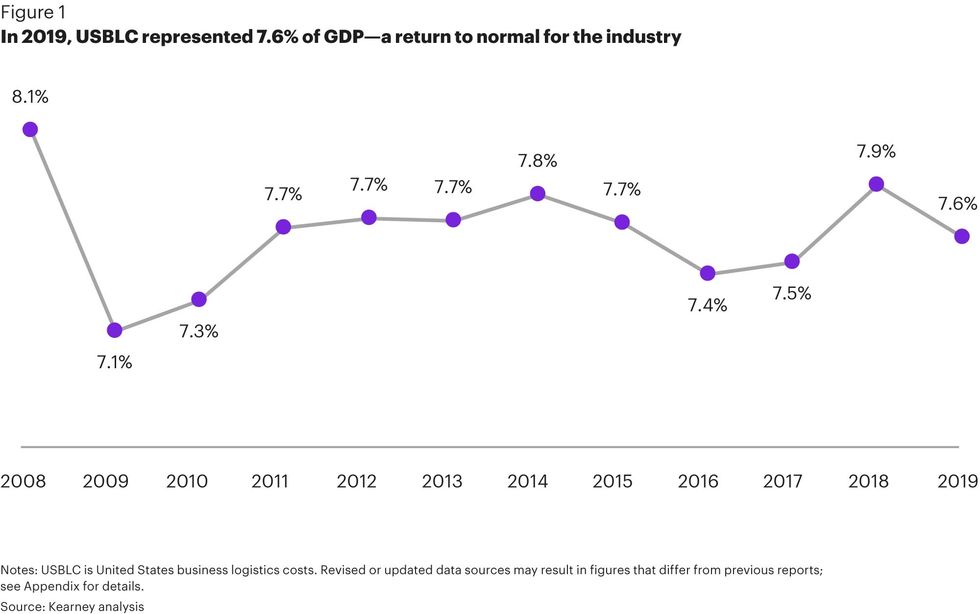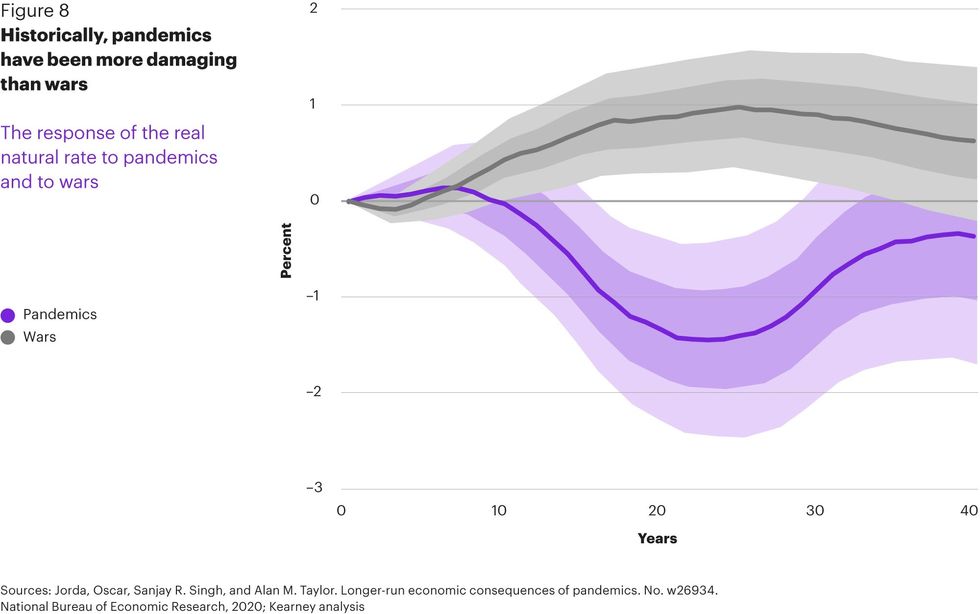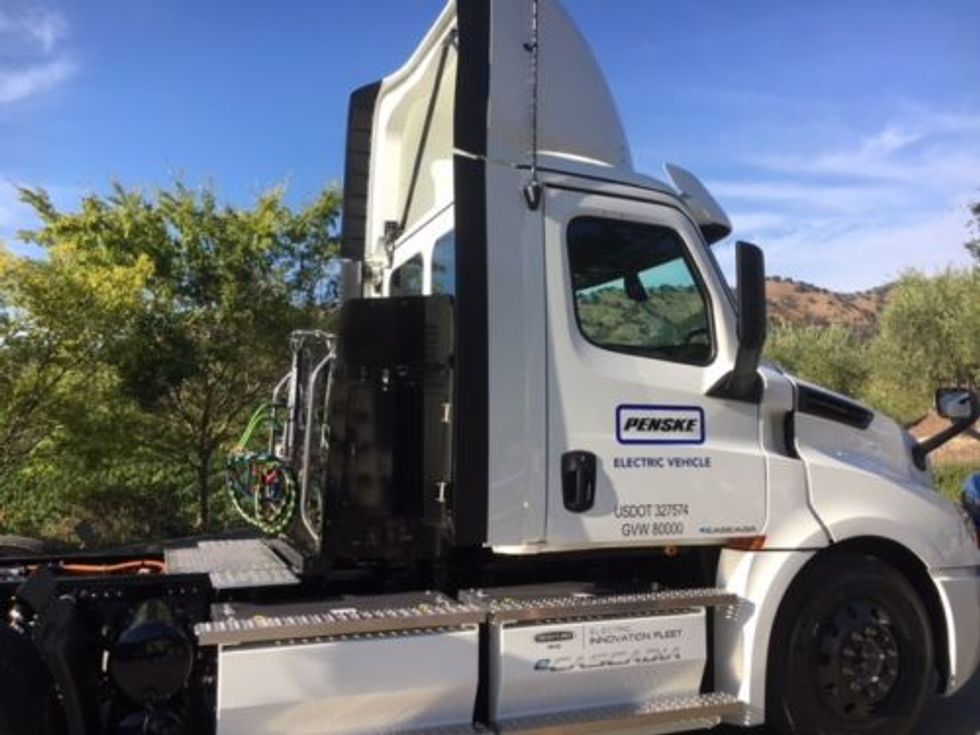Logistics experts shared their research findings during the Council for Supply Chain Management Professional's (CSCMP) EDGE Annual Conference in Anaheim, California.
Presenters included Balika Sonthalia, a vice president at A.T. Kearney and a presenter of CSCMP's 30th Annual State of Logistics Report, and Shanton Wilcox, partner at Infosys Consulting, which produces the 24th Annual Third-Party Logistics Study: The State of Logistics Outsourcing. Penske Logistics sponsors both studies.
Joe Carlier, Penske senior vice president of global sales, was a panelist for both the State of Logistics Report panels and the 3PL Study. The State of Logistics Report was unveiled earlier this year in Washington, D.C.
The 2020 24th Annual Third-Party Logistics Study shows that shippers and their third-party logistics providers work together to achieve supply chain success and that they have positive interactions.
The study shows that the vast majority of shippers—93%—report that the relationships they have with their 3PLs generally have been successful. A higher number—99%—of 3PLs agree that their customer relationships generally have been successful.
Among respondents participating in the 2020 study, 83% of shippers and 98% of 3PL providers agree that the use of 3PLs has contributed to improving services to the ultimate customers. Additionally, 66% of 3PL users and 93% of 3PL providers agree that 3PLs provide new and innovative ways to improve logistics effectiveness.
State of the Supply Chain
The logistics industry reached a crossroads in 2018 after toughing out constrained capacity and rising prices in 2017, according to the State of Logistics Report. In 2018, demand softened, but not to the point where a steep decline was visible.
So far in 2019, economic indicators are giving mixed signs. "If indeed we are heading into a recession, then trucking will see the lag effect, and we will be back to a right market," Sonalitha said. “But with the China trade war getting a breath of relief, we might be a few steps away from that."
That said, Sonalitha said she has been urging shippers to not give up on the discipline of being the shipper of choice to stay in control in case the market starts to tighten again.
Supply Chain Costs
The State of Logistics Report found rising costs across all segments of the industry in 2018, including transportation and inventory carrying costs. Inventory led the way with a 13.2% overall cost increase on a 4.6% rise in year-over-year inventories as trade tension buildups met declining demand.

Transportation costs saw a 10.4% increase, but specific modes saw significant jumps, and freight rates were up across the board. Among private fleets, there was a 13.1% increase, but the full truckload spike was high as well at 7.6% over 2018.
According to the Third-Party Logistics Study, supply chain costs are one of the top factors in shippers' operations decisions, with 91% reporting that they consider shipping expenses, which include costs associated with crating, packing, handling and freight.
More than half, 60%, consider product cost; 59% consider customs, including duties, taxes, tariffs, VAT, broker fees and harbor fees; 52%, of shippers consider overhead costs, such as purchasing staff, due diligence cost, travel and exchange rates. Also, 42% considered the cost of risk, such as insurance, compliance, quality and safety stock cost, in their operations decisions.
Among 3PLs, 92%, reported that they consider shipping costs; 61% consider overhead costs; 55% consider the cost of risk, such as insurance, compliance, quality and safety stock cost, in their operations decisions; 47% consider product cost; and 44% consider customs.
Langley noted that domestic and global economic changes have resulted in heavy pressure on supply chains to adapt to new economic circumstances. Some of these changes include cross-border relations with trading partners, Brexit, changing tariff structures, and the execution of agile strategic sourcing, manufacturing and distribution practices in today's supply chains, the Third-Party Logistics Study reported.
The Need for Technology
Shippers are increasingly aware that if they do not have the technological capabilities to accomplish their goals, they should partner with those that do, Langley said. As the availability of data increases, shippers and their logistics partners will need to be able to take the information and make it relevant. Many 3PLs are already making significant investments in technology that allow them to analyze shippers' operations.
As reported in the Third-Party Logistics Study, the majority of shippers—94%—agree that IT capabilities are a necessary element of 3PL expertise, and 56% of shippers agree they are satisfied with 3PL IT capabilities.

Technology is also playing a critical role in capturing data, which can be used to fuel analytics. Langley said the use of analytics is gaining significantly in terms of frequency of use, levels of sophistication and utilization of available computational capabilities.
Among shippers, taking part in the Third-Party Logistics Study, 39% indicated their involvement with 3PLs was significant, 36% somewhat, and 25% not at all. From the 3PL perspective, 43% indicated they had significant involvement, 43% somewhat, and 14% not at all.
Langley said 66% of shippers and 74% of 3PLs are in agreement that the use of analytics is a key to successful working relationships. Although shippers and 3PLs strongly agreed that analytics capabilities are a necessary element of 3PL expertise, they also agreed that they were only minimally satisfied with those capabilities, marking the existence of an analytics gap.
The Role of the Last Mile
The introduction and expansion of multi-channels for distribution has been a game-changing factor in the planning and operations of many supply chains, Langley said.
This phenomenon has challenged the ability of traditional brick-and-mortar retailers to adapt their supply chain practices to respond to what seems to be a continually-increasing number of customer and consumer needs, according to the Third-Party Logistics Study.
Parcel and last-mile services are struggling with costs, and being profitable on last-mile continues to be a challenge for carriers, Sonalitha said. “Hence, yes, there is demand for logistics solutions, such as those offered by tech startups like LogiNext," she explained.

Consumer goods are increasingly moving to faster deliveries, which means forward inventory deployment and agility in the omni-channel. "The role of logistics providers to enable omni-channel fulfillment is a hot topic, especially in the context of home goods and bulky items that customers want to be fulfilled anytime anywhere," Sonalitha said. “Tech startups, like Dematic and many more, are out there with promising solutions."
Due to the growth in residential deliveries, routes are getting longer and less efficient. Plus, the variability in volumes, such as those seen during the Thanksgiving to Christmas window, create a surge that providers have to manage, which is driving demand for 3PL services.
Customer expectations are continuing to increase, and same-day delivery is now approximately a $1 billion industry, the State of Logistics Report said. It is the fastest-growing service type for e-commerce deliveries.
Interest in Sustainability
Environmental sustainability is taking on greater importance globally and can also make good business sense. “Once relegated to the world of corporate social responsibility, businesses in the logistics sector and beyond are finding efficiencies and cost savings through sustainability improvements, including through procurement, supply chain, and waste management practices," according to the State of Logistics report.
As a result, more and more shippers are embracing sustainability programs, and carriers and 3PLs are focusing on greening efforts to attract shippers, Langley said. The Third-Party Logistics Study found that public perception and cost savings are driving sustainability within logistics for shippers as well as their third-party logistics providers. At the same time, there are multiple ways shippers and 3PLs are integrating sustainable environmental processes into the traditional supply chain.
 Penske Truck Leasing took delivery of one of the first Daimler Trucks North America LLC (DTNA) Freightliner electric eCascadia Class 8 trucks earlier this year.
Penske Truck Leasing took delivery of one of the first Daimler Trucks North America LLC (DTNA) Freightliner electric eCascadia Class 8 trucks earlier this year.
Langley said the majority of shipper respondents, 76%, said they are participating in optimization, such as route planning and load consolidation; 42% said they are involved in tracking and reporting emissions; 38% said they are taking part in voluntary programs, such as the Environmental Protection Agency's SmartWay program; and 16% said they are piloting alternative fuels.
Among 3PLs, 78% said they are participating in optimization; 63% said they are taking part in voluntary programs; 39% are involved in tracking and reporting emissions; 19% said they are piloting alternative fuels.
As an example, companies like Penske Truck Leasing and Penske Logistics are leading the transportation industry by adding not only electric truck charging stations to truck terminals but they're also already operating and maintaining an array of electric vehicles including light-duty, medium-duty, and heavy-duty battery electric trucks in fleet delivery settings.
Shippers are also becoming more interested in alternative fuel options and sustainable technologies. Manufacturers are continuing to move forward with alternative fuel options as well as advanced technologies, such as automated vehicles or platooning vehicles.
By “Move Ahead" Staff
 Bob Costello
Bob Costello  Tim Denoyer
Tim Denoyer John Langley
John Langley Mark Baxa
Mark Baxa  Nate Springer
Nate Springer  Penske Logistics senior sales leader Andy Moses (center) was a panelist for this year's presentation of the CSCMP State of Logistics Report, presented by Penske. The event took place at the National Press Club in Washington, D.C.
Penske Logistics senior sales leader Andy Moses (center) was a panelist for this year's presentation of the CSCMP State of Logistics Report, presented by Penske. The event took place at the National Press Club in Washington, D.C.






